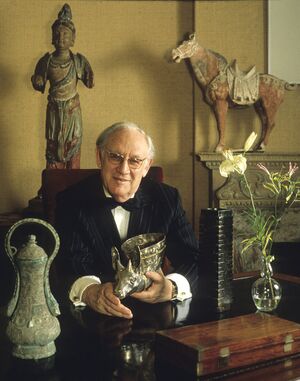Arthur Sackler
(Big Pharma executive, businessman, art collector) | |
|---|---|
 | |
| Born | August 22, 1913 New York City, U.S. |
| Died | May 26, 1987 (Age 73) New York City, U.S. |
| Nationality | US |
| Alma mater | New York University |
| Religion | Jewish |
| Relatives | • Mortimer Sackler • Raymond Sackler |
"No single individual did more to shape the character of medical advertising than the multi-talented Dr. Arthur Sackler. His seminal contribution was bringing the full power of advertising and promotion to pharmaceutical marketing." | |
Arthur Mitchell Sackler was an American psychiatrist and marketer of pharmaceuticals whose fortune originated in medical advertising and trade publications.
The Medical Advertising Hall of Fame wrote in 1998,
"No single individual did more to shape the character of medical advertising than the multi-talented Dr. Arthur Sackler. His seminal contribution was bringing the full power of advertising and promotion to pharmaceutical marketing."[1]
With Sackler's help, the pharmaceutical giant Pfizer, previously a chemical manufacturer, began its business in prescription drugs.[2] In 1950, Pfizer had 8 salesmen and expanded that force to 2000 in 1957.[1] Between 1950 and 1956, with Sackler's guidance, Pfizer competed in the new antibiotic marketplace with Terramycin.[1]
Through direct marketing to physicians during the 1960s, he popularized dozens of medicines including Betadine, Senaflax, Librium, and Valium. He became a publisher and started a weekly medical newspaper in 1960, the Medical Tribune, which eventually reached six hundred thousand physicians (by some reports his audience was a million[3] physicians in 20 countries). Sackler's marketing of Valium in journals like Medical Tribune helped to make it the first drug to generate $100 million in sales, and by 1971, Librium and Valium earned US $2 billion for his client, Hoffmann-La Roche.[4] As a result of his success, many other drug companies began marketing their drugs in a similar fashion.[5]
References
- ↑ a b c https://doi.org/10.1056%2FNEJMp1902811
- ↑ https://www.forbes.com/sites/alexmorrell/2015/07/01/the-oxycontin-clan-the-14-billion-newcomer-to-forbes-2015-list-of-richest-u-s-families/#4d0bbb0775e0
- ↑ http://www.sackler.org/about
- ↑ https://doi.org/10.1016%2F0271-5384%2881%2990020-X
- ↑ http://fortune.com/2011/11/09/oxycontin-purdue-pharmas-painful-medicine/